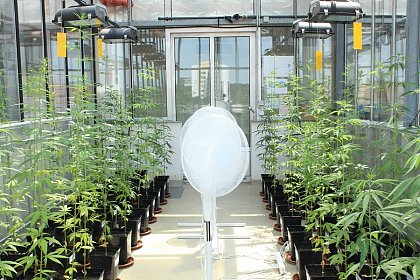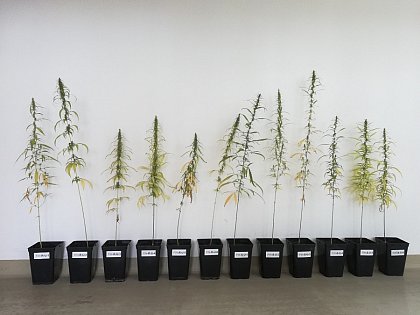Industrial hemp - an ecological and economic opportunity for the recultivation of open-cast lignite mining areas?

Industrial Hemp-Greenhouse experiment
Photo: Aaron Tinschert
The cultivation of renewable raw materials is increasingly coming into focus, particularly against the backdrop of climate change, and one resource is indispensable for this - soil.
Soil fulfils a variety of tasks for ecosystems, such as providing a habitat for plants, storing nutrients and filtering precipitation, as well as providing the basis for housing and infrastructure. For mankind, agricultural utilisation for food production in particular is of crucial importance. Soil properties and site factors, such as soil type, water holding capacity, nutrient storage and availability, root penetration and depth are of crucial importance.
In recent decades, mature soils in Germany have been excavated in open-cast mines for the extraction of lignite and thus removed from any utilisation. After coal extraction, some of the open-cast mines were remodelled as recreational areas in the form of lakes, e.g. Leipziger Neuseenland, or backfilled with the excavated soil. The areas created after backfilling must be recultivated so that they can be used for agriculture again, as they have poorer properties compared to natural soils. The focus here is on building up humus and improving the soil structure, which can be achieved in particular with the cultivation of various crops (e.g. field peas or lucerne) in site-dependent crop rotations.

Industrial hemp strain "Finola" on Regosol (Plant 1-6) and on Chernozem (Plants 7-12) Photo: Aaron Tinschert
Um die Auswirkungen von Bodeneigenschaften, gepaart mit sich verändernden klimatischen Verhältnissen (z.B. Niederschlagsmengen) auf den Ertrag, aber vor allem auf die Inhaltsstoffe von Nutzhanf zu untersuchen, führt unsere Arbeitsgruppe Gewächshausexperimente durch, wobei die Analytik der Samen und Blüten im Hinblick auf ihre Chemovariabilität im Vordergrund steht.
In einem ersten Gewächshausexperiment unter optimalen Bedingungen wurden drei Nutzhanfsorten (Fedora 17, Finola, Futura 75) auf einem Kipp-Regosol (Herkunft: Tagebau Profen) und einer Schwarzerde (Herkunft: Bad Lauchstädt) jeweils als gedüngte und ungedüngte Variante angebaut und entsprechend ihrer Nutzung (Samen, Blüten, Fasern) geerntet. Ziel des Versuches war es herauszufinden, inwieweit sich Erträge und Inhaltsstoffe der ausgewählten Nutzhanfsorten auf den Standorten unterscheiden.




